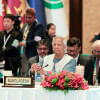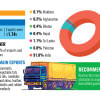[WATCH] Evolution of Bengal coins: From Hercules to Bangabandhu
If someone paid you in coins today, chances are you will reject it. Even beggars do not want to take alms in coins any more. But it is these coins that have survived through thousands of years carrying with them crucial tales from history. They tell people of the glorious times in which they were created.
The ancestors of Bengal had a rich heritage, and if you glance through the coins from the different periods you will see a perspective of that history being reflected on them.
The oldest coin found in Bangladesh dates back to more than 2500 years.
Found in Wari-Bateshwar archeological site, these punch-marked coins were issued in abundance by the Magadha Empire (545 to 7th century BC). These Imperial Punch-Marked coins were imprinted on silver carrying symbols of cows, flowers or the sun.
Oddly enough, the next set of oldest coins, which dated back to the 1st century, was engraved with the portrait of Greek legend Hercules. These coins were found in Mainamati.
The first gold coin of Bengal issued around 102 AD was also found in Mainamati showing an anonymous king rising from the clouds holding a royal scepter.
As there was no gold and silver mining in Bengal, whatever gold and silver Bengal had possessed at that time came through favorable balance of payment from foreign trade. Gold coins were especially used to give tax to the King.
Symbols and legends used in the coins were often associated with the ruling family. Sultani coins Sikka and Khutbah were considered symbols of sovereignty in the Islamic world. Therefore, after major events such as assuming power or the declaration of independence and sometimes to commemorate victory, sultans used to strike coins.
During the Afghan period, Sher Shah for the first time initiated the system of inscribing the ruler's name.
From the beginning of the Mughal rule, Bengal’s tradition of her own coinage system ceased to exist. The central government controlled coin production. During the colonial period, machine was introduced for the first time in manufacturing coins. And the tradition of machine made coins still continues in Bangladesh.
The last significant person to be engraved in coins is Bangabandhu Sheikh Mujibur Rahman, who was the face of five taka coins issued in 1997.
Source: Coins From Bengal by Professor AKM Shanawaz and Associate Professor Bulbul Ahmed.

 For all latest news, follow The Daily Star's Google News channel.
For all latest news, follow The Daily Star's Google News channel. 








Comments